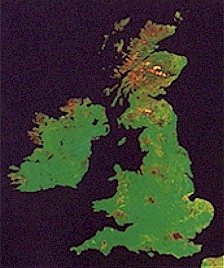Geology & Scenery
| The Lake District in the
middle of Cumbria contains the highest mountains in England as well as most of the
country's lakes. There are numerous peaks of more that 700 metres, with the highest
being Scafel Pike at 977 (more that 3000 feet). The middle part of the massif,
through which the walk passes, is composed of a group of Ordician rocks termed the Borrowdale
Volcanic series. Most of the high peaks are composed of these igneous rocks which
have been able to withstand erosion well. During the last Ice Age, the area was the source of many glaciers which carved the deep U-shaped valleys and sculpted the sharp ridges or arrętes characteristic of the area. When the ice finally retreated about 10,000 BC, lakes formed in the valleys, giving the scenery that we see today. The glaciers started in bowl shaped corries at the valley heads, which now often contain marshes or small lakes known as tarns. The rock scraped away by the movement of the ice was finally deposited as glacial till. These heaps of stones and clay, may form rounded heaps known as drumlins, or strips along the valley edge in the form of lateral moraines. Larger heaps formed at the melting snout of the glacier are termed terminal moraines. On the walk, the typical Lakeland scenery starts at the western edge of Ennerdale Water and ends abruptly by the dam of Haweswater Reservoir. There is then a limestone plateau extending as far as Kirkby Stephen. |
| The Yorkshire Dales are
basically a section of the Pennines, the central mountain ridge of England which extends
from the north midlands up to Scotland. The mountains here are lower than those
of the Lake District, and therefore show fewer effects of glaciation. The
peaks are much more rounded without sharp ridges, and the valleys or dales are more
open. Also most of the rock is sedimentary, limestones and shales low down and
harder gritstones on the tops. Because the limestone is porous, there are very few
lakes, and streams have a habit of disappearing into caves via sink holes. In the past, there was a lot of lead mining in the dales. Melbecks Moor between Keld and Reeth is covered with huge areas of disused mine workings and spoil heaps, which are still largely bare of plants. The Dales end east of Richmond, when the walk enters the flat farmland of the Vale of York, which stretches eastwards to the North York Moors. |
| Osmotherly is situated on the western
edge of the North York Moors, which comprise the scenery of the final part of the
walk. The Moors are lower than both the Lakes District mountains and the Pennines,
and comprise of a vast grouse moor of low rounded heather covered hills. It was due
to the featurelessness of the area, that the famous medieval stone crosses were erected,
the remains of which can still be seen. The end of the walk at Robin Hood's Bay features an impressive set of cliffs composed of lias. Lias is a soft crumbly rock containing vast numbers of fossilised ammonites. The cliffs are so soft, that they have been eroded to such an extend that a wide flat bed of rock is exposed at low tide. This bed is where the old cliffs have been worn away to the level of the waves. I picked a small pebble from the beach containing several ammonite fossils as a souvenir. Such is the softness of the rock, that it has been slowly crumbling ever since, and in few years should be totally reduced to a mixture of powder and ammonite shells. |
Wainwright's Coast to Coast walk
